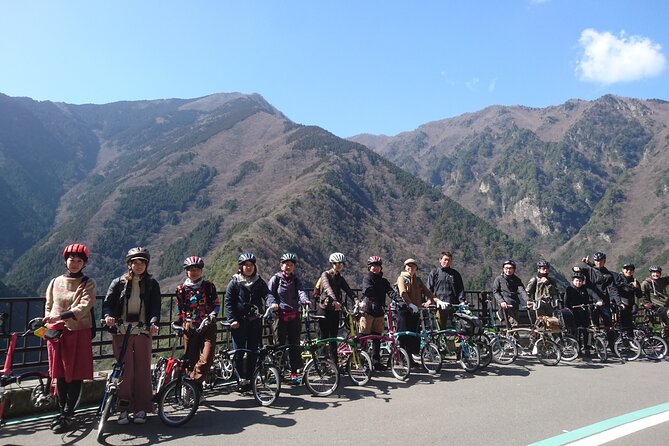At the Sweets Making & Kimono Tea Ceremony in Gion Kiyomizu, visitors are invited to indulge in a culinary journey that combines the art of confectionery with the elegance of a traditional tea ceremony. Participants will learn to craft wagashi, delightful Japanese sweets that are as visually stunning as they are delicious.
Under the guidance of a skilled host, guests will discover the secrets behind these intricate treats and gain hands-on experience in shaping and decorating them. To fully enjoy the experience, you will also have the opportunity to don a kimono-style chef jacket, adding a touch of authentic charm.
Prepare to be transported to a world of sweetness and grace at the Sweets Making & Kimono Tea Ceremony in Gion Kiyomizu.
Quick Takeaways

- Participants have the opportunity to learn the art of making traditional wagashi confections.
- The host explains the historical and symbolic meaning behind each wagashi confection.
- Wagashi are intricately shaped into various forms and characters according to the seasons.
- Wagashi confections make perfect souvenirs that capture the essence of Japanese culture.
Overview and Experience
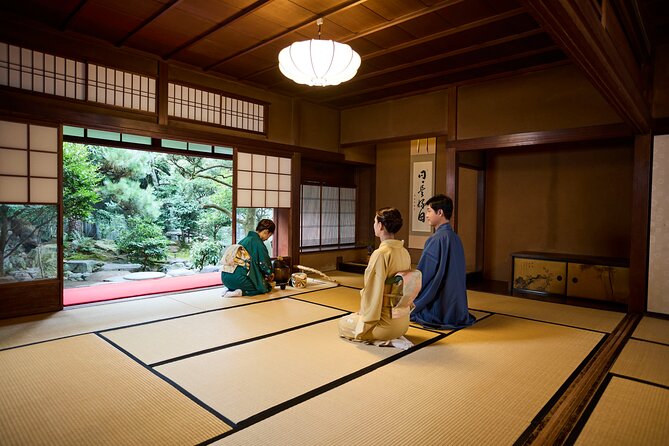
The experience at Sweets Making & Kimono Tea Ceremony Gion Kiyomizu offers a unique opportunity to learn the art of making traditional wagashi confections. These confections, served with tea, are an integral part of Japanese culture and can be shaped into various forms and characters according to the seasons.
The host of the ceremony demonstrates the proper cooking techniques, allowing participants to learn firsthand. The cultural significance of wagashi is highlighted throughout the experience, as the host explains the historical and symbolic meaning behind each confection.
Participants also have the chance to wear a kimono-style chef jacket, adding to the authenticity of the experience.
Traditional Japanese Confections
Wagashi, traditional Japanese confections, are a beloved part of Japanese culture and are intricately shaped into various forms and characters according to the seasons. These delicate sweets aren’t only pleasing to the eye, but also to the palate.
Here are three fascinating facts about wagashi shapes and their significance:
- Seasonal Designs: Wagashi makers pay attention to the changing seasons and create confections that reflect the beauty of nature during that time. For example, cherry blossom-shaped wagashi are popular in the spring, while maple leaf-shaped ones are enjoyed in the autumn.
- Symbolism: Each wagashi shape carries a symbolic meaning. For instance, the round shape represents harmony and completeness, while the chrysanthemum shape signifies longevity and beauty.
- Tea Ceremony Etiquette: When enjoying wagashi during a tea ceremony, it’s customary to eat it in three bites. The first bite is to appreciate the appearance, the second to savor the flavor, and the third to fully enjoy the texture.
These unique wagashi shapes and the tea ceremony etiquette add to the charm and cultural richness of Japan.
Seasonal Shapes and Characters
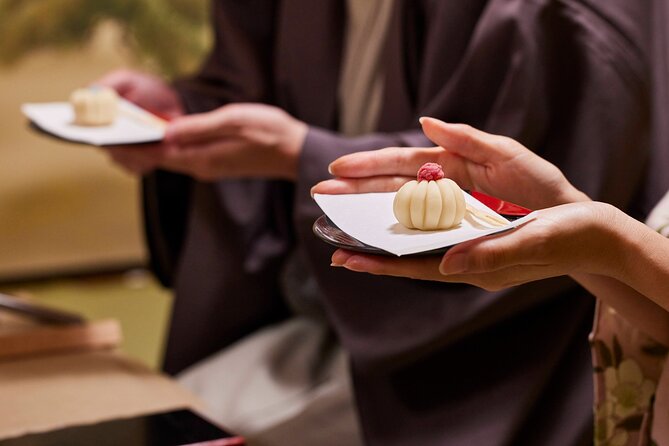
Seasonal wagashi in Japan are crafted into an array of shapes and characters that reflect the changing seasons. Wagashi shaping techniques play an important role in creating these intricate designs. Molds, hand cutting, and shaping by hand are some of the techniques used by skilled wagashi artisans. These techniques allow them to create shapes that resemble flowers, leaves, animals, and even traditional Japanese symbols.
The cultural significance of seasonal shapes in wagashi can’t be overstated. It’s believed that these shapes not only enhance the visual appeal of the confections but also evoke a sense of harmony with nature and the passing of time. For example, cherry blossom-shaped wagashi are commonly enjoyed during spring, symbolizing the fleeting beauty of the sakura season. Similarly, maple leaf-shaped wagashi are popular in autumn, representing the vibrant colors of the changing leaves.
The attention to detail and symbolism in these seasonal shapes make wagashi a unique and delightful culinary art form.
Perfect Souvenirs
Crafting seasonal shapes and characters in wagashi not only creates visually appealing confections but also produces perfect souvenirs that capture the essence of Japanese culture and culinary artistry. These limited availability treats hold a significant place in Japanese traditions and are highly sought after by both locals and travelers.
Here are three reasons why wagashi makes for the perfect souvenir:
- Cultural Significance: Wagashi reflects the rich cultural heritage of Japan. Each shape and design is carefully crafted to represent specific seasons, festivals, or symbolic meanings. By gifting wagashi, one can share a piece of Japanese culture and history with their loved ones.
- Exquisite Craftsmanship: The intricate detailing and craftsmanship involved in making wagashi are truly remarkable. From delicate cherry blossoms to adorable animal shapes, these confections showcase the skill and dedication of the artisans. Souvenirs that display such artistry are sure to leave a lasting impression.
- Unique and Authentic: Unlike mass-produced items, wagashi are made in small quantities using traditional techniques and high-quality ingredients. This ensures that every piece is unique and authentic. By offering wagashi as a souvenir, one can provide a truly special and memorable gift that can’t be found elsewhere.
Cooking Techniques and Kimono-style Chef Jacket
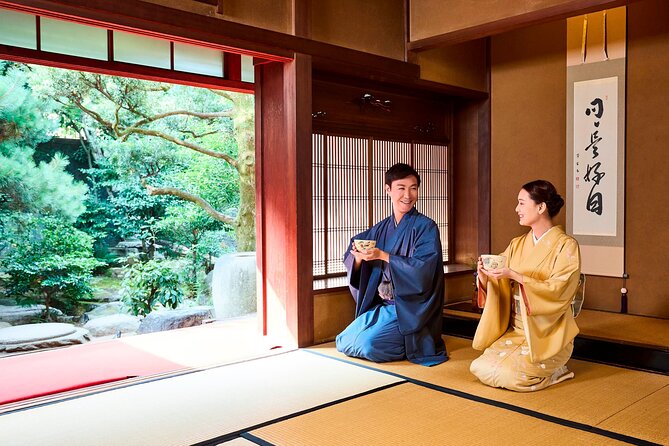
The host of the Sweets Making & Kimono Tea Ceremony Gion Kiyomizu experience showcases their expertise in cooking techniques while donning a kimono-style chef jacket, adding to the cultural authenticity of the event. With meticulous attention to detail, the host guides participants through the process of making wagashi, traditional Japanese confections served with tea.
Despite the challenges of wearing a kimono-style chef jacket, the host effortlessly demonstrates various cooking techniques, such as shaping the wagashi into different forms and characters according to the seasons. This unique combination of culinary skills and cultural attire creates a truly immersive and unforgettable experience for participants, allowing them to learn about Japanese cooking traditions while embracing the beauty of the kimono-style chef jacket.
Confirmation and Accessibility
The confirmation process for the Sweets Making & Kimono Tea Ceremony Gion Kiyomizu experience ensures that participants have a seamless booking experience and provides essential details for their visit. Upon booking, you will receive a confirmation email containing all the necessary information for their upcoming activity. This includes the date, time, and location of the tea ceremony, as well as any specific instructions or requirements.
In terms of accessibility, it’s important to note that the venue isn’t wheelchair accessible. However, it’s conveniently located near public transportation, making it easily reachable for most visitors. It’s also worth mentioning that children under the age of 7 aren’t allowed in the tea ceremony venue. This information allows potential participants to plan accordingly and make informed decisions about their visit.
Tea Ceremony Venue Restrictions
Located in Gion Kiyomizu, the tea ceremony venue has specific restrictions that visitors should be aware of. One of the restrictions is regarding children. Children under the age of 7 aren’t allowed in the tea ceremony venue. This is to ensure a calm and serene atmosphere during the ceremony.
Another aspect to consider is the accessibility of the venue. Fortunately, the tea ceremony venue is conveniently located near public transportation, making it easily accessible for visitors. This means that getting to the venue shouldn’t be a problem and visitors can easily reach it using public transportation options.
These restrictions are put in place to ensure the best experience for all participants and to maintain the traditional and peaceful ambiance of the tea ceremony.
Cancellation Policy and Reviews
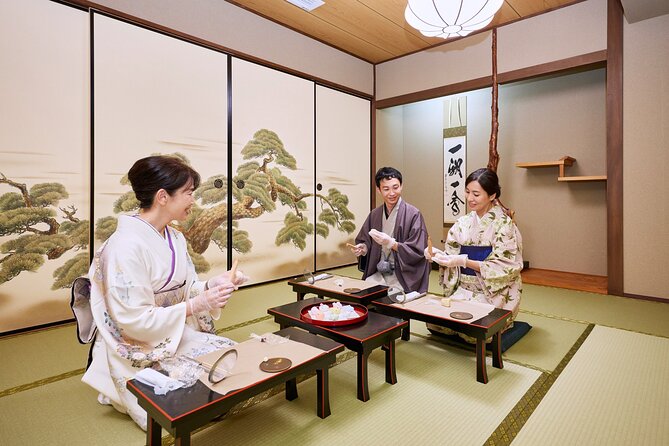
Visitors can find information on the cancellation policy and reviews for the Sweets Making & Kimono Tea Ceremony Gion Kiyomizu experience.
The cancellation policy for this experience allows for a full refund if canceled up to 24 hours in advance. However, if the cancellation is made less than 24 hours before the start time, no refund will be provided. Plus, no changes to the booking will be accepted less than 24 hours before the start time. It’s important to note that the cut-off times for cancellation and changes are based on the local time.
As for customer feedback, the experience has received reviews on both Viator and Tripadvisor. The overall rating is based on a scale of 1 to 5 stars, with 5 being the highest.
Frequently Asked Questions
What Is the History of Wagashi and How Long Has It Been a Part of Japanese Culture?
Wagashi, traditional Japanese confections, have a rich history and are deeply rooted in Japanese culture. They have been enjoyed for centuries, evolving with the seasons and serving as a symbol of hospitality and artistry.
Are There Any Specific Ingredients Used in Wagashi That Are Unique to Japan?
Wagashi, traditional Japanese confections, often incorporate unique ingredients that are specific to Japan. These ingredients can include red bean paste, matcha powder, and cherry blossoms. Plus, wagashi can be shaped into various traditional shapes and characters according to the seasons.
Can You Customize the Shapes and Characters of the Wagashi to Suit Personal Preferences?
Yes, the shapes and characters of wagashi can be customized to suit personal preferences. This allows for a unique and personalized experience when making these traditional Japanese confections.
How Long Does It Take to Learn the Proper Cooking Techniques for Making Wagashi?
The learning curve for mastering the proper cooking techniques of making wagashi varies depending on the individual. However, with the guidance of the host and the cultural significance of the process, participants can expect to acquire the necessary skills within a reasonable amount of time.
Is the Kimono-Style Chef Jacket Provided for Participants to Wear During the Experience or Is It Just for the Host?
The kimono-style chef jacket is provided for participants to wear during the experience. This adds to the authenticity and immersion of the activity. Participants will also have the opportunity to learn wagashi techniques and customize the shapes of their confections.
The Sum Up
To sum it up, the Sweets Making & Kimono Tea Ceremony at Gion Kiyomizu offers a unique and immersive experience for visitors. From learning the art of making wagashi to donning a kimono-style chef jacket, participants can fully enjoy Japanese culture.
The traditional Japanese confections aren’t only delicious but also visually appealing, with various shapes and characters depending on the season.
While children under seven aren’t allowed, the ceremony is conveniently located near public transportation for easy access.




